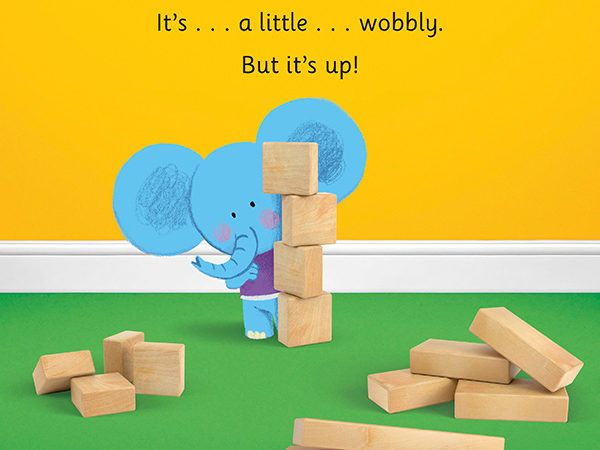This blog post is submitted by Robie H. Harris, children’s book author of CRASH! BOOM! A Math Tale, a 2019 Mathical award winner.
Young children, even infants and toddlers, are natural mathematicians and scientists. When new infants gaze into faces of the people in their day-to day lives, they are already observers. When older infants want more cereal and utter, “More!” and then have eaten all of their cereal and declare, “All gone!”—they are already comparing and understanding the mathematical concepts of “more” and “less.”
Toddlers and young children are keen observers and while observing, new ideas pop into their minds. Often that new idea is something they want to try to figure out. When they have the opportunity to play and build with hands-on materials such as blocks, the blocks can serve as tools that can help them figure out how to solve a problem—a math problem.
They may even pose their own math problems and try to solve them. Children, just like adults, when trying to solve a math problem, often express strong emotions. That’s why there are two interconnected stories within CRASH! BOOM! A Math Tale, a picture book I wrote for young children with art and photos created by Chris Chatterton.
One story is the solving of a math problem. The other story is the unfolding of the powerful emotions expressed in this story—hope, utter failure, the will to try again, and finally the pride and joy of success. And then some fun after all that.
The math problem in CRASH! BOOM! is posed, when Elephant, a stand-in for a young child, looks at the blocks strewn on the floor and ponders, “Hmmm. 1 Oh! 1 more. Hey! I want it to be as tall as ME! 2 more?” and so on. Elephant is trying out an idea just as young children do, by solving a math problem, in this case, “How can I build a tower as tall as me— given the objects I just discovered?”

Over the years, I have observed young children play and build with blocks in various settings: daycare centers, preschools, and kindergartens. I also observed my own children and grandchildren building with blocks at home. These various observations are what led me to create CRASH! BOOM! and to include a myriad of mathematical concepts that are now embedded within the words and images this story.
Here is a sampling of some, but not all of those concepts: combining, doubling, halving, adding, measurement, counting, balance, stability, instability, weight, gravity, shape, patterns, proportion, comparisons, and symmetry.

The basis of this book is that math for young children is not just about counting. It is also about the many other concepts young children can and do discover in their daily lives. Following are two examples of these concepts: When a shape is moved from one place to another, it remains the same shape. Measurement can determine the height of an object.
Many believe these concepts are not concepts young children can or will discover or understand. Many also believe young children do not have the capacity to see the inherent math concepts that pop up in their daily lives. In fact, research has affirmed that young children do have that innate capacity.
Likewise research has shown that early math promotes early literacy and language development. That can and does happen because while playing, many young children vocalize about what they observe and create. All we have to do is observe infants, toddlers, and young children as they play, vocalize and show us that in fact, they are natural mathematicians.
This is why it matters that they have a multitude of opportunities to play with hands-on materials. Playing with, manipulating and building with blocks give young children endless possibilities to discover and problem-solve throughout their early years so they can continue to be mathematical thinkers throughout their lives.
CRASH! BOOM! A MATH TALE. Text copyright © 2018 by Robie H. Harris. Illustrations copyright © 2018 by Chris Chatterton. Reproduced by permission of the publisher, Candlewick Press, Somerville, MA.
